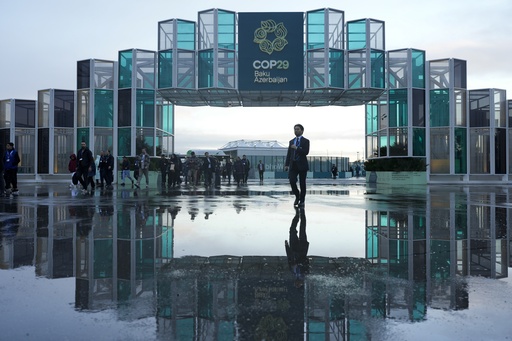
BAKU, Azerbaijan — For the third consecutive year, the initiatives aimed at combating climate change have failed to lower the estimates of how much the Earth’s temperature is expected to rise. Recent events in both China and the United States are anticipated to worsen the situation slightly, according to a new analysis released on Thursday.
This report coincides with the 29th United Nations climate conference currently taking place in Baku, where nations are striving to establish new benchmarks for reducing emissions of greenhouse gases. Additionally, they are deliberating on the financial contributions that wealthier countries will make to assist in achieving these reduction targets.
According to the Climate Action Tracker, a collaborative of scientists and analysts monitoring governmental policies, the planet is on track to experience a temperature increase of 2.7 degrees Celsius (or 4.9 degrees Fahrenheit) from pre-industrial levels. If the emissions continue to rise while temperature projections stagnate, questions arise about the effectiveness of the United Nations climate negotiations, known as COP.
“There are many positive developments underway, but in terms of the overall effectiveness of emission reduction efforts, it feels broken to me,” remarked Bill Hare, one of the lead analysts.
The largest contributors to emissions have become impediments to climate action. The Earth’s temperature has already increased by 1.3 degrees Celsius (2.3 degrees Fahrenheit) since the pre-industrial era, dangerously close to the 1.5 degrees Celsius (2.7 Fahrenheit) threshold established during the 2015 Paris climate agreement. Experts say that the warming, primarily driven by human dependency on fossil fuels, is resulting in increasingly severe and damaging weather events such as droughts, floods, and dangerous heat waves.
Climate Action Tracker provides several projection scenarios, some of which indicate slight increases. One prediction based on countries’ promises for 2030 suggests a rise to 2.6 degrees Celsius, which is a tenth of a degree warmer than earlier estimates. The analysts’ most optimistic scenario, which assumes full compliance with nations’ pledges, still projects an increase to 1.9 degrees Celsius, also up by a tenth of a degree from last year, as noted by Sofia Gonzales-Zuniga of Climate Analytics.
“This upward trend is particularly influenced by China,” stated Gonzales-Zuniga, indicating that while emissions in China are beginning to plateau, they have peaked at higher levels than expected.
The upcoming U.S. elections may also influence these forecasts. If a future Trump administration were to reverse the climate policies set forth in the Inflation Reduction Act and implement the conservative Project 2025 agenda, it could add an additional 0.04 degrees Celsius (0.07 Fahrenheit) to warming projections. Although this increase may seem minimal, it could provoke other countries to limit their climate actions based on U.S. policy changes, potentially exacerbating the situation further. Moreover, a cut in American financial support could have wider implications for future temperature forecasts.
Hare emphasized that the United States appears to be moving backwards regarding climate initiatives, while China’s situation offers more hope for significant future reductions in emissions.
“We should be seeing a decline in global emissions by now, but that is not the case,” Hare pointed out. He added that in light of the climate emergencies being witnessed, including deadly floods in regions like Nepal and Valencia, Spain, the political response remains insufficient and should raise concerns globally.
One critical discussion amidst the Baku conference examines how wealthy nations will assist poorer countries in moving towards cleaner energy systems, adapting to climate impacts, and compensating for the damage caused by climate-related extreme weather. The previous commitment of $100 billion per year in assistance is nearing expiration, and the primary aim of the talks is to formulate a new, more substantial financial target.
An independent assembly of experts, tasked by the United Nations Secretary-General Antonio Guterres, released a report calling for a threefold increase in the prior financial commitment.
“The advanced economies must show a genuine commitment to aiding poorer nations,” the report highlighted.
A coalition of developing nations in attendance at the talks is seeking $1.3 trillion annually in climate funding. Furthermore, the independent group’s report emphasized that about $1 trillion per year is required to support climate-related efforts in these countries, which should come from various external funding sources, not solely government donations.
It elaborated on the costs of transitioning to a decarbonized global economy and outlined possible funding sources. Overall, expenditures needed for climate adaptation across all nations are anticipated to reach $2.4 trillion annually.
“A significant increase in investments is essential across all countries for a transition to clean, low-carbon energy, enhancing resilience against climate change effects, addressing loss and damage, and safeguarding nature and biodiversity,” the report concluded.
